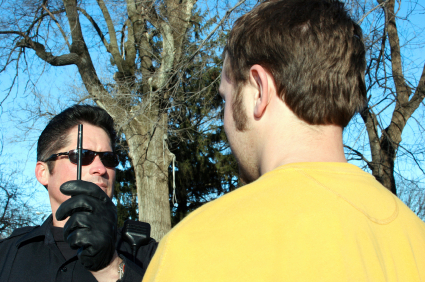
Field sobriety testing is the term describing a series of tests the police give a motorist whom they suspect to be impaired by alcohol or drugs.
The tests were developed after study by the U.S. Department of Transportation (DOT), National Highway Traffic and Safety Administration (NHTSA). Three tests were approved for standardization and use by law enforcement throughout the country:
- Horizontal gaze nystagmus
- Walk and turn
- One leg stand
These tests were standardized. A procedure was developed to administer these tests in the same way for every DUI arrest. The notion is that the tests are valid and accurate predictors of impairment only if they are given according to protocol.
The acronym for field sobriety test is FST, and standardized field sobriety tests are referred to as SFSTs.
A person who was arrested for DUI in Illinois should refer to the Notice of Summary Suspension. The police officer probably wrote either FSTs or SFSTs showed signs of impairment, or that the driver failed the tests. If the notice indicates this, then the police officer used the performance on the tests as probable cause to make the arrest. The field sobriety tests will also be used as evidence in the criminal trial for the offense of DUI.
A police officer can make an arrest for driving under the influence based on field sobriety testing alone. He does not have to obtain a breath sample on the portable breath test (PBT) device.
In cases where the driver refuses the chemical testing, such as not blowing into the breathalyzer at the police station, then the prosecution’s case rests on the field sobriety testing.
The Horizontal Gaze Nystagmus Test (HGN)
Nystagmus is the involuntary jerking of the eye. This trait occurs naturally in all people, but studies have shown that alcohol and drugs can enhance nystagmus.
The horizontal gaze nystagmus test, called the HGN, measures involuntary jerking of the eyes horizontally. Basically, this test involves a police officer asking the driver to follow a pen with his eyes side to side.
Testing procedures are under development for vertical gaze nystagmus, which, as the name suggests, measures involuntary jerking of the eye from following an object up and down. It is said that vertical gaze nystagmus measures the effects of drugs.
During the test, the police officer is looking for three things:
- Lack of smooth pursuit
- Distinct nystagmus at maximum deviation
- Onset before 45 degrees
Lack of smooth pursuit is the term used to describe the inability of the eyes to follow the pen smoothly as it moves from side to side. Apparently, a sober person’s eyes would look like a marble rolling across glass, but an intoxicated person’s eyes would move in a jerking way.
Distinct nystagmus at maximum deviation refers to pronounced, intense jerking of the eyes when the eye is moved to the very limit of the person’s peripheral vision. An officer would look for extreme jerking of the pupils when the suspect’s eyes are all the way to one side or the other (maximum deviation from eyes looking straight forward).
Onset of nystagmus before 45 degrees means involuntary jerking of the eye before the person is looking 45 degrees away from center. The NHTSA studies demonstrated that intoxicated people would show nystagmus before 45 degrees, but an ordinary person would not.
Instructions for the HGN Test
The police officer administering the HGN test should advise the suspect in the following manner:
I am going to check your eyes.
The officer would then ask the person to remove any glasses or contact lenses, which can affect the test.
Now keep your head still and follow this object with your eyes.
The officer can use any object as the stimulus, including a finger, pen, or flashlight.
Do not move your eyes back to the center until I tell you.
A suspect who moves his head should be reminded to keep still. The police officer may also choose to hold the person’s head in place with his hand or flashlight.
The officer is supposed to check the person’s left eye first. He should take his pen, holding it at least 12 inches from the person’s face, and move it to the right over two seconds. When the eye is over as far as it will go, he should look for jerking of the eyeball. This is nystagmus at maximum deviation.
He should then bring the pen back to center, and move the pen again to the right more slowly, over four seconds. Here, the officer is looking for nystagmus before 45 degrees from center.
Throughout these two movements, two seconds and four seconds, the officer is looking for lack of smooth pursuit.
The two movements of two seconds followed by four seconds should be repeated for the other eye.
The HGN test has three criteria for judging whether the person has passed the test:
- Lack of smooth pursuit.
- Onset of nystagmus before 45 degrees.
- Distinct nystagmus at maximum deviation.
If the officer observes any of these clues, he is to assign one point. These three criteria apply to both the left and right eye. Thus, there is a total of 6 possible points in the test. A score of 4 points is failing the HGN.
The Walk and Turn Test (WAT)
The walk and turn test is known by most people as walking a straight line, or walking an imaginary line. More or less, these are accurate descriptions of the test, but these terms fail to adequately describe the difficulty of performing the walk and turn.
The walk and turn is a divided attention test, because the subject is required to perform two tasks simultaneously. The subject is required to assume a starting position and maintain that position while listening to instructions for performing the remainder of the test. Most people do not maintain the starting position while hearing all the instructions.
Instructions for the WAT
The police officer conducting the walk and turn should give the driver the following instructions:
Please put your left foot on the line and then your right foot in front of it like this.
The police officer should demonstrate by placing his right foot in front of his left touching heel to toe.
When I tell you to begin, take nine heel-to-toe steps down the line, turn around, and take nine heel-to-toe steps back.
At this point, the officer should walk down a line heel-to-toe. The line does not need to be marked, although if a line is present on the pavement, it can be used.
Note that the driver is already standing with his right foot in front of his left. Therefore, the first step is made by stepping out with the left foot in front of the right.
The officer should advise the driver to make the turn by keeping one foot on the line and using the other to turn. He should demonstrate by making 3-4 small steps around in a semi-circle with the right foot, until his body is facing back towards where he started.
Keep your hands at your sides, watch your feet at all times, and count your steps out loud. Do you understand?
The officer should wait for the motorist to respond that he understands the instructions.
Before the driver proceeds with stepping out, the officer should tell him,
Begin by counting your first step from the heel-to-toe position as “one.”
The test has nine criteria used to judge whether the subject has passed:
- The subject cannot maintain his balance while listening to instructions.
- The subject begins before receiving all the instructions.
- The driver stops walking to steady his self.
- The person fails to touch heel-to-toe.
- Stepping off the line.
- Using arms to balance.
- Losing balance while turning.
- Taking an incorrect number of steps.
- The person is unable to perform the test.
The test subject is assigned one point for each of the above criteria. In case the subject stops in the middle of the test, the police officer is supposed to tell him to continue the test from that point, not start over.
As few as two points is a failed test, and the subject is presumed intoxicated.
The One Leg Stand Test (OLS)
The one leg stand, or one legged stand, basically involves standing on one foot and counting to 30. This is one field sobriety test that many judges believe is a difference-maker in trial. If the driver performs well, some judges believe the defendant should be found not guilty.
Injuries can cause the subject to perform poorly on this test. Accordingly, the police officer should inquire about any injuries to hips, knees, ankles, or feet.
The NHTSA field sobriety testing manual tells the officer that if the person has high heels or shoes with heels that are two inches tall, the shoes should be removed. In these situations, the test would be completed barefoot or in socks only.
Instructions for the OLS
The officer should tell the subject the following:
Please stand with your heels together and your arms down at your sides, like this.
The police officer should demonstrate by standing in such a way.
The officer should then tell the subject,
When I tell you to, I want you to raise one leg about six inches off the ground and hold that position. At the same time, count from 1001 to 1030 while watching your foot.
The officer should demonstrate by pointing his toes upward while counting 1001, 1002, 1003 and 1004, etc.
The police officer should then ask the driver:
Do you understand?
The one leg stand test judges the driver on the following criteria:
- Swaying while balancing. Swaying either side-to-side or back-and-forth is a sign of intoxication.
- Using arms for balance. If the driver raises his arms more than six inches from the leg at any given time, this counts as one point.
- Hopping on one foot.
- Putting the foot back down.
- The driver is unable to do test. If the driver puts his foot down three times or more during the test, the officer concludes he is physically unable to perform the test.
The police officer should assign the driver one point for each of the above criteria that is observed. A score as low as two points is considered a failed test, and the driver is presumed to be drunk.

